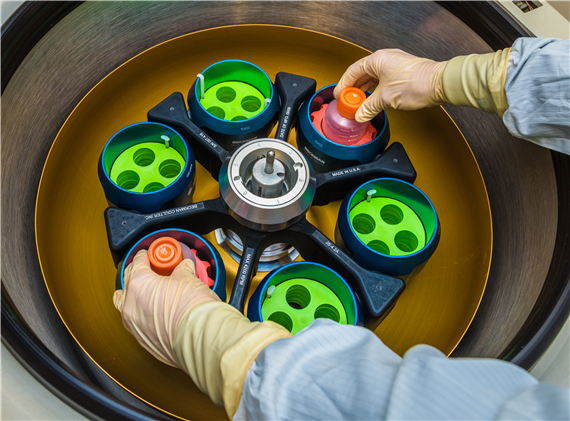Expanded Lab Facility at Dana-Farber aids personalized medicine efforts
Lab supports more than 600 stem cell transplants and more than 40 clinical trials
A ribbon cutting celebrating the expanded and renovated Connell and O’Reilly Families Cell Manipulation Core Facility (CMCF) was held today at Dana-Farber Cancer Institute. Laurie H. Glimcher, MD, president and CEO of Dana-Farber Cancer Institute and Jerome Ritz, MD, Executive Director of the CMCF were joined by Travis McCready, president and CEO of the Massachusetts Life Sciences Center at the event celebrating the importance of this lab in cutting edge biomedical research.
A unique, all-inclusive research and contract manufacturing facility providing novel cellular therapies for clinical settings, the CMCF has expanded to 30,000 square feet (almost triple its former size). The lab collaborates with biotech companies and other academic research centers to develop techniques for regenerating healthy cells for conditions such as cancer, immune deficiency, sickle cell disease, diabetes, kidney failure, cornea scarring and ALS (amyotrophic lateral sclerosis or Lou Gehrig’s disease).
This expanded lab, funded in part by a $4.6 million grant from the Massachusetts Life Sciences Center, is built to very specific standards to ensure that products are consistently produced and controlled so they’re safe for patient use. Using highly specialized and dedicated air handling systems and air locked clean rooms, the facility is more like one found at a pharmaceutical company than at an academic medical center.
The lab processes cells from more than 600 adult and pediatric stem cell transplants every year and supports more than 40 ongoing clinical trials. Therapies made in this lab include CAR T cells, immune cells retrofitted with genes that improve their ability to stalk and attack cancer cells, cancer vaccines; mesenchymal and limbal stem cells; induced pluripotent stem cells and genetically altered stem cells that make transplants available to patients who might not otherwise be eligible. They are most often made for an individual patient, representing the ultimate in precision medicine. These approaches are being tested in clinical trials at Dana-Farber and other area hospitals.
“Our renovated facility for the production of cellular products is one of the largest in an academic center in the world. It serves as a cornerstone for all sectors of the life sciences community in Massachusetts, building on our longstanding commitment to accelerate cancer drug development through collaboration and partnership,” said Glimcher.
“The Connell and O’Reilly Families Cell Manipulation Facility was expanded to meet the challenges associated with manufacturing therapeutic cells for an increasing number of disease indications. This represents a new therapeutic paradigm where we develop “living drugs” for individual patients – a true personalized approach. With this unique resource we will be able to make cellular therapies faster with higher quality to benefit larger numbers of patients,” said Ritz.
“At a most basic level, the reason we are all here is to help humanity and we can accomplish this by increasing capacity for innovation, supporting new partnerships, and creating the space for the delivery of new therapies and treatments,” said Massachusetts Life Sciences Center President & CEO Travis McCready. “As we move toward the next generation of our life sciences ecosystem, the MLSC remains committed to supporting education and innovation at academic institutions to meet the needs of our state’s fastest-growing industry.”
Media Contacts
If you are a journalist and have a question about this story, please call 617-632-4090 and ask to speak to a member of the media team, or email media@dfci.harvard.edu.
The Media Team cannot respond to patient inquiries. For more information, please see Contact Us.
